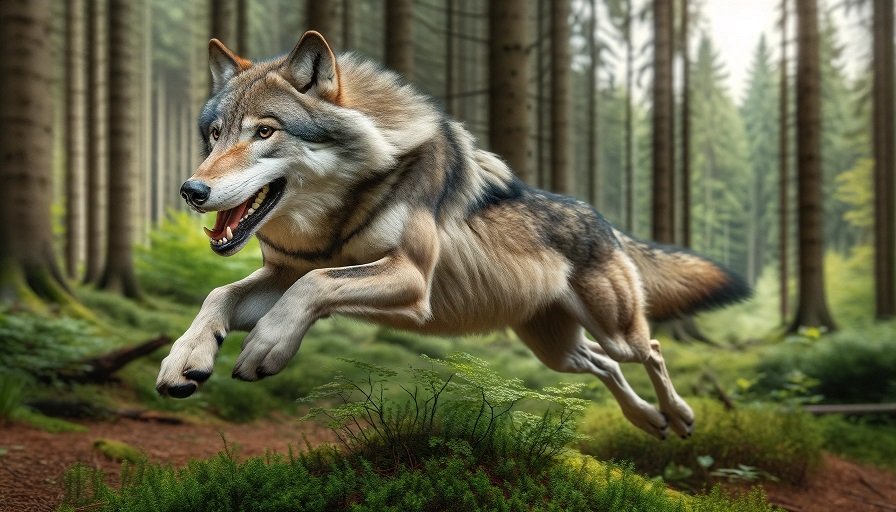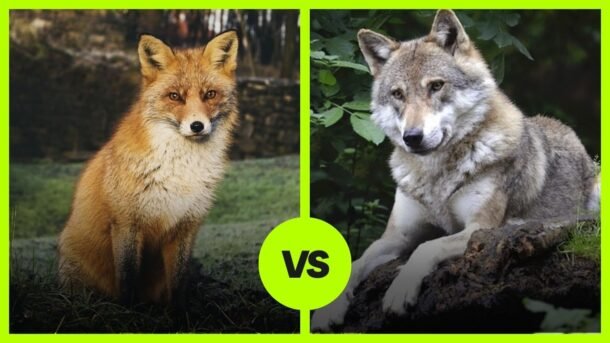In the animal kingdom, where survival often hinges on strength, speed, and strategy, hypothetical battles between different species can be fascinating thought experiments. The matchup of a red fox versus a grey wolf is one such intriguing scenario. These two members of the Canidae family, though related, differ greatly in size, behavior, and hunting techniques, leading to a compelling comparison in terms of their combat capabilities.
The Combatants
Red Fox: The Cunning Opportunist
- Size and Physicality: Red foxes are much smaller than grey wolves, with an average weight of about 14 pounds. They are known for their agility and speed.
- Behavior and Strategy: Foxes are solitary hunters, relying on stealth and cunning to catch a variety of prey, including rodents, birds, and even insects. They are opportunistic feeders and have adapted well to diverse environments, including urban areas.
- Combat Skills: In confrontations, foxes are more likely to flee than fight. They are not adapted to fighting larger predators and would likely use their speed and agility to escape a threat rather than engage.

Grey Wolf: The Pack Hunter
- Size and Physicality: Grey wolves are significantly larger and more powerful, with adults weighing between 70 to 145 pounds. They possess a robust build suited for endurance and strength.
- Behavior and Strategy: Wolves are pack animals, known for their complex social structures and cooperative hunting strategies. They primarily prey on large ungulates, employing tactics that involve chasing and overpowering their prey.
- Combat Skills: In a fight, wolves use their size, strength, and numbers to their advantage. They are capable of delivering powerful bites and can work together to take down much larger animals.
The Showdown
In a hypothetical confrontation between a red fox and a grey wolf, several key factors would influence the outcome:
Physical Advantage
The physical disparity between a grey wolf and a red fox is stark and plays a crucial role in determining the likely victor in a hypothetical battle. Grey wolves are significantly larger and stronger than red foxes. An adult wolf can weigh anywhere from 70 to 145 pounds, towering over the modest 14-pound frame of a typical red fox. This size advantage isn’t just in weight but also in the wolf’s muscular build, designed for endurance and overpowering prey. In a direct confrontation, this size and strength disparity gives the wolf a formidable edge. The wolf’s powerful jaws and large teeth are capable of delivering lethal bites, something the smaller fox is not equipped to counter effectively. In the animal kingdom, where size and strength often determine the outcome of physical confrontations, the grey wolf’s superior physicality would likely be the decisive factor.

Combat Experience
In the wild, the experiences that shape an animal’s combat skills are crucial. Grey wolves have a lifestyle that imbues them with significant combat experience. They are accustomed to hunting large ungulates like deer and elk, which require a strategic and often forceful approach. Additionally, wolves defend their territory against other predators, including rival wolf packs, which further hones their combat skills. This experience in dealing with threats and challenges is a stark contrast to the life of a red fox. Foxes, being solitary hunters, focus on smaller prey and employ stealth rather than force. They lack the experience of confronting and overpowering larger adversaries, which is a daily reality for wolves. This difference in combat experience means that in a confrontation, the wolf is more adept at handling and winning physical battles, using its honed skills and instincts developed through a life of challenging hunts and territorial defense.
Tactical Approach
The tactical approach of each animal in a confrontation is also a critical factor. The red fox, known for its agility and cunning, is an adept hunter in its own right. However, its skills are tailored more towards stealth and evasion, suited for hunting small prey like rodents and birds. Foxes are masters of the element of surprise, using their speed and agility to outmaneuver their prey. In a potential conflict with a grey wolf, these traits would likely manifest in a strategy aimed more at escape than engagement. The fox’s smaller size and solitary nature mean that it is not equipped to engage in combat with a larger, more powerful predator. The wolf, on the other hand, has a tactical approach shaped by its life in a pack. Wolves coordinate with their pack members in hunts, using sophisticated strategies to chase and overpower large prey. This cooperative approach and the experience of dealing with sizable adversaries mean that in a confrontation with a fox, the wolf would likely be the aggressor, utilizing its size, strength, and pack tactics to dominate.
In summary, when considering the physical advantage, combat experience, and tactical approach of both the grey wolf and the red fox, the wolf emerges as the clear favorite in this hypothetical showdown. Its superior size, strength, combat skills, and strategic hunting approach make it a formidable opponent against the smaller, more elusive red fox.
Conclusion and Winning Chances
Considering the physical attributes, behavioral patterns, and combat skills of both animals, the grey wolf would overwhelmingly be the likely victor in this matchup. The wolf’s superior size, strength, and pack-based hunting strategy give it a clear advantage over the smaller, more solitary red fox, which is not equipped to handle such a formidable opponent in combat.
The Verdict: Chances for Each
Here’s the deal:
- Red Fox: 5%
- Grey Wolf: 95%
While such encounters are rare in the wild, as both species usually avoid direct conflict, this theoretical battle highlights the stark differences in their adaptations and survival strategies within the Canidae family.
For more fascinating animal showdowns, be sure to check out these articles:
- Delve into the unique dynamics of pack behavior and hunting strategy in Wolf vs. Lion: Who Would Win, a captivating analysis of these two apex predators.
- Explore the contrast between agility and strength in Chimpanzee vs. Fox: Who Would Win, offering a glimpse into the different survival tactics of these animals.
- Understand the power of cooperation versus individual cunning in Wolf vs. Dog: A Battle of Cousins or Unequal Matchup, highlighting the differences between wild and domestic canines.




